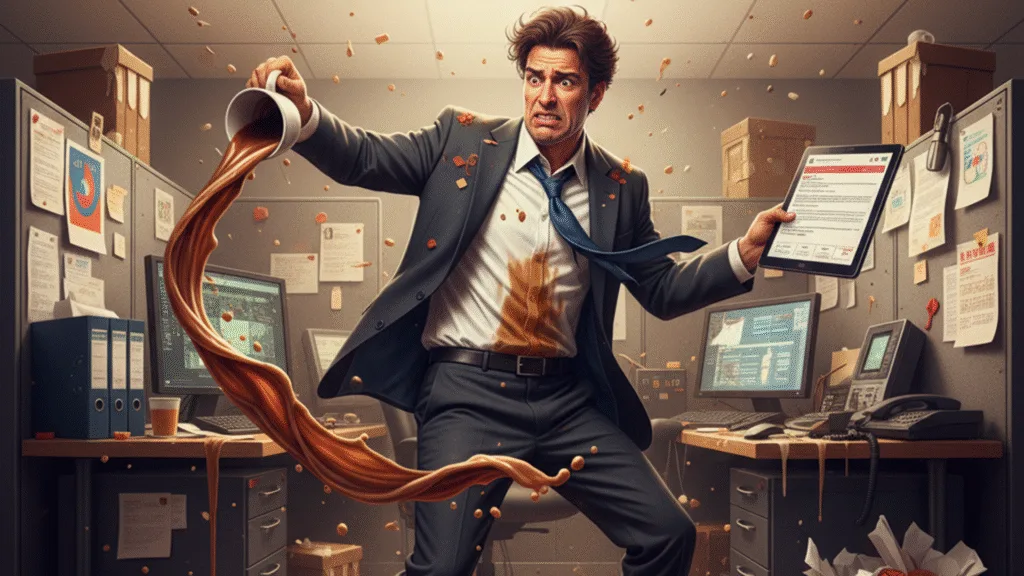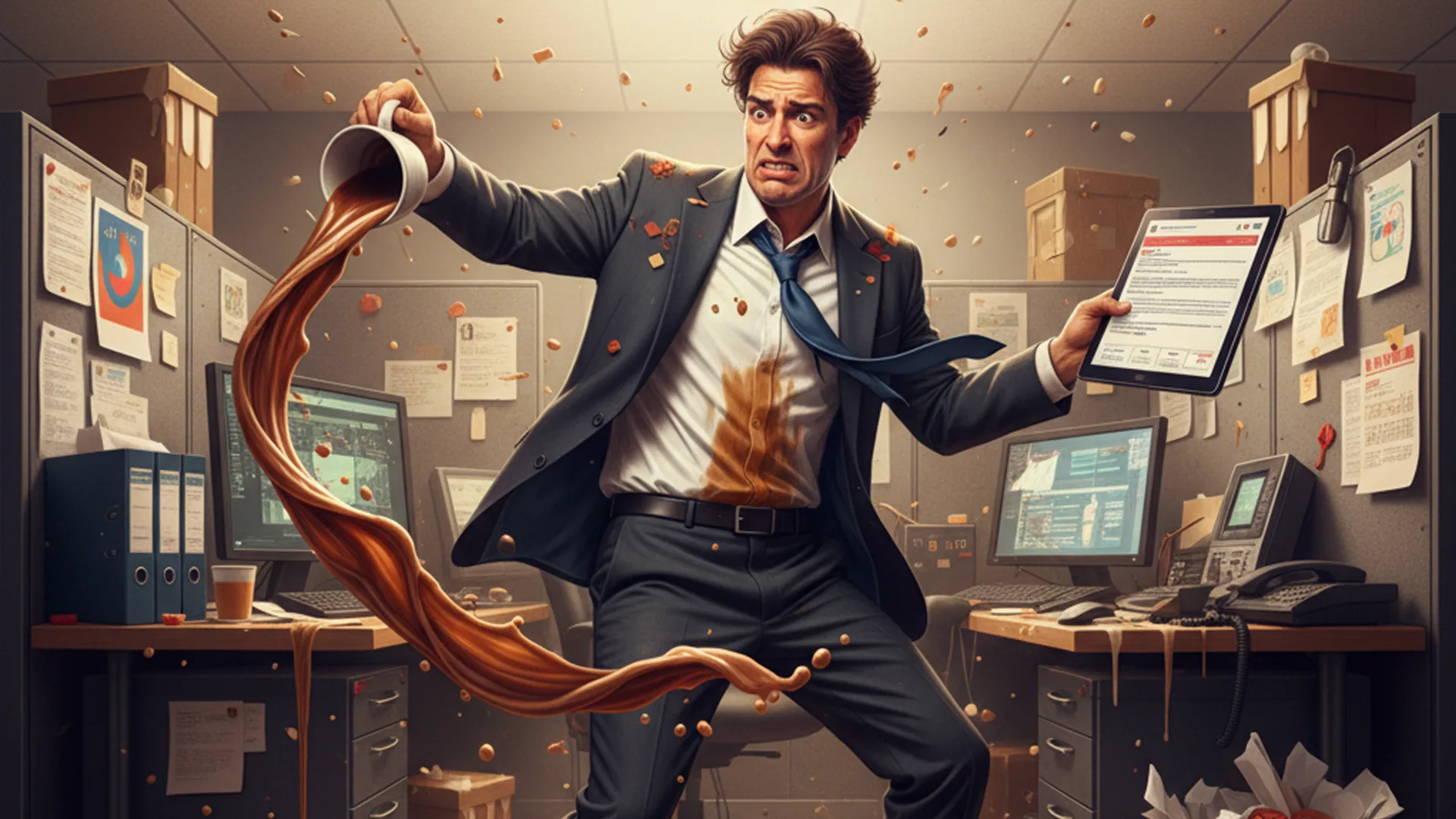The Buzz Behind Business
Your Guide to Caffeinating Your Cranium, Cleverly.
An astonishing
85%
of people in the U.S. consume at least one caffeinated beverage daily. It’s not just a drink; it’s a global ritual and a professional tool.
How It Works: The Brain on Caffeine
Caffeine’s magic isn’t actually about *giving* you energy; it’s about tricking your brain into not feeling tired. It achieves this by impersonating a natural compound called Adenosine.
1. Adenosine Builds Up
Throughout the day, this compound promotes sleepiness by binding to its receptors.
2. Caffeine Arrives
With a similar structure, caffeine swoops in and blocks Adenosine receptors.
3. Alertness Ensues
With receptors blocked, the brain’s own stimulants (like Dopamine) work more freely, enhancing focus.
The Cognitive Kick
When used correctly, caffeine demonstrably improves key cognitive functions essential for learning and productivity.
On Neuro-diversity
For some individuals, particularly those with ADHD, caffeine’s stimulant properties can have a paradoxically calming and focusing effect, helping to quieten mental noise and improve concentration. It’s not a replacement for medical treatment, but its impact highlights that one size does not fit all.
Key Takeaway
The same substance can yield different results based on brain chemistry. Understanding this is key to inclusive event planning.
The Ultimate Event Fuel
At long conferences and tradeshows, mental fatigue is inevitable. Caffeine helps bridge the gap, maintaining engagement levels throughout the day.
Brewing Best Practices
DO: Hydrate Simultaneously
Caffeine is a mild diuretic. Pairing each cup with a glass of water prevents dehydration and headaches.
DON’T: Drink on Empty
Consuming caffeine on an empty stomach can lead to jitters and stomach upset. Pair it with a meal or snack.
DO: Know Your “Cut-Off” Time
With a half-life of ~5 hours, consuming caffeine late in the afternoon can disrupt sleep. Stop by 2-3 PM.
DON’T: Use It to Replace Sleep
It’s a temporary patch, not a long-term solution for sleep deprivation. Prioritize rest for true performance.
DO: Offer Alternatives at Events
Provide high-quality decaf, herbal teas, and water to ensure all attendees feel comfortable and catered for, respecting diverse health needs and preferences.

The Brain on Caffeine: Your Morning Meeting with a Psychoactive Drug
The World’s Most Socially Acceptable Stimulant
For a vast portion of the professional world, the workday doesn’t begin until the first cup of coffee has been consumed. It is the planet’s most popular and widely consumed psychoactive substance, a central nervous system (CNS) stimulant that has woven itself into the very fabric of modern productivity. With data suggesting that roughly 80% of U.S. adults partake daily, and with white-collar workers consuming an average of 3-4 cups per day, caffeine is less a beverage and more a non-negotiable tool of the trade.
Yet, for all its ubiquity, a surprising fog surrounds what this drug is actually doing to the organ we rely on for our livelihoods: the brain. We speak of it in vague terms, “it wakes me up,” “it helps me focus”, without appreciating the elegant and sometimes brutal neurochemical ballet taking place behind the scenes. This series aims to pull back that curtain. Over three parts, we will move beyond simplistic “good vs. bad” arguments to build a nuanced, strategic understanding of caffeine. We will explore how it works, how to leverage its benefits, how to mitigate its risks, and how to build a healthier, more intentional relationship with this powerful chemical ally. First, we must understand the machinery it manipulates.

The Great Impostor: How Caffeine Hijacks Your Brain’s Fatigue Signals
To understand caffeine, one must first understand its nemesis: adenosine. Throughout your waking hours, as your neurons fire and your brain consumes energy, they produce a byproduct called adenosine. This neuromodulator gradually accumulates in the spaces between your neurons and, like a rising tide, begins to bind to specific receptors, primarily the A1 and A2A subtypes. This binding action has a depressant effect; it slows down nerve cell activity, causes blood vessels in the brain to dilate, and generates the growing sensation of drowsiness we call “sleep pressure”.5 It is your brain’s natural, gentle signal that it’s time to wind down.
Enter caffeine. From a molecular perspective, caffeine is a masterful impostor. Its three-dimensional structure is strikingly similar to that of adenosine, allowing it to fit perfectly into adenosine receptors like a key into a lock. But here is the crucial difference: while the key fits, it does not turn. Caffeine occupies the receptor, a process known as antagonism, but it doesn’t activate it. It simply sits there, physically blocking the real key, adenosine, from getting in. The result? The “I’m tired” signal is never received. Your nerve cells, no longer being told to slow down, speed up instead.
This mechanism reveals a fundamental truth: caffeine does not create energy. It is not an energy ATM. It is a neurological loan shark. It doesn’t give you a fresh supply of alertness; it merely masks your fatigue by silencing the alarm bells. While caffeine is busy squatting in your adenosine receptors, your body, oblivious to the deception, continues to produce adenosine in the background. This pool of sleep-inducing chemical builds and builds, waiting for its chance. When the caffeine is finally metabolized and vacates the receptors several hours later, this accumulated flood of adenosine rushes in, binding to all the newly available sites at once. This is the “caffeine crash”, the sudden, often overwhelming wave of exhaustion that is simply the deferred payment on your alertness loan, frequently with interest.

The Domino Effect: Adrenaline Surges and the “Dopamine Question”
Caffeine’s primary act of blocking adenosine sets off a cascade of secondary effects throughout the brain. With the brakes of adenosine removed, other excitatory neurotransmitters, such as norepinephrine and glutamate, can operate more freely, leading to a general increase in neuron firing. Your brain’s pituitary gland senses this uptick in activity and, interpreting it as a potential emergency, sends a hormonal signal to the adrenal glands. The adrenal glands respond by producing adrenaline (epinephrine), the body’s “fight or flight” hormone.
This adrenaline surge is responsible for the familiar physical “jolt” of caffeine: your heart rate increases, blood pressure rises, airways open up, and the liver releases sugar into the bloodstream for extra energy. It is a state of physiological emergency, a system-wide alert that, while useful for escaping a predator, is perhaps overkill for a Tuesday morning budget meeting.
The story becomes even more intricate when we examine dopamine, the neurotransmitter famously associated with pleasure, motivation, and reward. It is often claimed that caffeine works like cocaine by slowing dopamine reabsorption, but this is a misleading oversimplification. Advanced neuroimaging studies reveal a more subtle and fascinating mechanism. At the doses typically consumed by humans, caffeine does not cause a significant increase in dopamine release in the brain’s primary reward centers, such as the nucleus accumbens.
Instead, caffeine acts as a “dopamine signal amplifier.” This is because the A2A adenosine receptors that caffeine blocks are often physically coupled with D2 dopamine receptors in the brain, forming what are known as heteromers. When adenosine binds to its A2A receptor, it inhibits the function of its partner D2 receptor, effectively dampening dopamine’s signal. By antagonizing the A2A receptor, caffeine removes this inhibitory brake. It doesn’t create more dopamine, but it makes the D2 receptors more available and more sensitive to the dopamine that is already present. This explains how caffeine can enhance mood, motivation, and alertness, all functions tied to dopamine, without producing the intense euphoria or high addictive potential of substances that cause a massive dopamine flood. It isn’t writing new music for the orchestra; it’s simply telling the conductor to let the brass section play louder.

Tolerance, Dependence, and Withdrawal: The Price of a Daily Habit
The brain is a remarkably adaptive organ. When it detects that its adenosine receptors are being chronically blocked, it compensates by building more of them, a process known as upregulation. This adaptation is the biological basis of caffeine tolerance. With more adenosine receptors available, a larger dose of caffeine is required to block a sufficient number of them to achieve the same feeling of alertness. The single espresso that once powered your morning eventually becomes a double, and then a triple.
This upregulation inevitably leads to physical dependence. The brain re-calibrates its baseline state, assuming the constant presence of caffeine to function “normally”. When the drug is suddenly removed, this new, hyper-sensitive system is thrown into chaos. The now-oversupply of adenosine receptors is flooded by the body’s natural adenosine, leading to a powerful wave of inhibitory signals that manifest as the classic symptoms of caffeine withdrawal.
The throbbing headache, often the most pronounced symptom, is caused by the rebound dilation of blood vessels in the brain, which caffeine had been constricting. This is accompanied by profound fatigue, drowsiness, irritability, difficulty concentrating, and a depressed mood. These effects are not merely subjective; they are the signs of a genuine physiological withdrawal syndrome, one that is clinically significant enough to be included in the Diagnostic and Statistical Manual of Mental Disorders (DSM-5). Symptoms typically begin 12 to 24 hours after the last dose, peak within one to two days, and can last for up to nine days as the brain slowly downregulates its adenosine receptors back to a non-caffeinated baseline. This uncomfortable process is the price of a daily habit, and it is the primary driver that keeps many people locked in the cycle of consumption.
Join us at the Strategy Table to read part 2 and 3 of this post JOIN NOW
Read Part 2 – Supercharging Cognition, Mood, and Networks: JOIN TO READ
Read Part 3 – – The Mindful Buzz A Strategic Guide for Neurodiversity, Events, and a Healthier Habit: JOIN TO READ
See References: CLICK HERE
